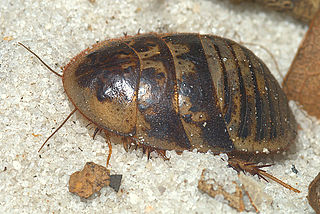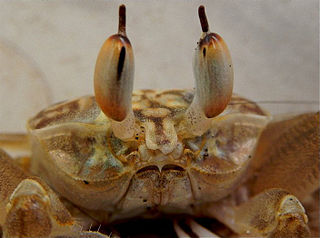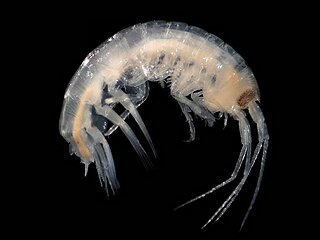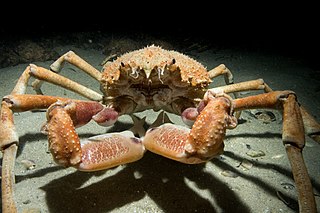
Amphipoda is an order of malacostracan crustaceans with no carapace and generally with laterally compressed bodies. Amphipods range in size from 1 to 340 millimetres and are mostly detritivores or scavengers. There are more than 9,900 amphipod species so far described. They are mostly marine animals, but are found in almost all aquatic environments. Some 1,900 species live in fresh water, and the order also includes the terrestrial sandhoppers such as Talitrus saltator and Arcitalitrus sylvaticus.

Emerita is a small genus of decapod crustaceans, known as mole crabs, sand fiddlers, or sand crabs. These small animals burrow in the sand in the swash zone and use their antennae for filter feeding.

Ocypode is a genus of ghost crabs found in the sandy shores of tropical and subtropical regions throughout the world. They have a box-like body, thick and elongated eyestalks, and one claw is larger than the other in both males and females. They inhabit deep burrows in the intertidal zone. They are primarily nocturnal, and are generalist scavengers and predators of small animals. The genus contains 21 species.

Talitridae is a family of amphipods. Terrestrial species are often referred to as landhoppers and beach dwellers are called sandhoppers or sand fleas. The name sand flea is misleading, though, because these talitrid amphipods are not siphonapterans, do not bite people, and are not limited to sandy beaches.

Arenivaga is a genus of sand cockroaches, of the subfamily Corydiinae, in the family Corydiidae. These cockroaches live in sandy soils and dunes in the southwestern United States, Florida and Mexico. Arenivaga comes from the Latin arena meaning sand and vagus meaning wandering.

Orchestia is a genus of amphipods in the family Talitridae. Species in Orchestia are parasitized by the Filozoan species Txikispora philomaios.

A giant isopod is any of the almost 20 species of large isopods in the genus Bathynomus. They are abundant in the cold, deep waters of the Atlantic, Pacific, and Indian Oceans. Bathynomus giganteus, the species upon which the generitype is based, is often considered the largest isopod in the world, though other comparably poorly known species of Bathynomus may reach a similar size. The giant isopods are noted for their resemblance to the much smaller common woodlouse, to which they are related.

Talitrus saltator, a species of sand hopper, is a common amphipod crustacean of sandy coasts around Europe. The animal's typical "hopping" movement gives it its common name, and is produced by a flexion of the abdomen. In order to do this, it must stand on its legs and suddenly extend its abdomen from under its body. It can thus leap several inches into the air, although without any control over its direction. A great deal of scientific research has been carried out on the animal, to determine the environmental cues which it uses to control its behavior.

Dardanus megistos, the white-spotted hermit crab or spotted hermit crab, is a species of hermit crab belonging to the family Diogenidae.

Ocypode gaudichaudii, also known as the painted ghost crab or cart driver crab, is a species of crab found on Pacific beaches from El Salvador to Chile as well as on the Galápagos Islands. The species was first described by Henri Milne-Edwards and Hippolyte Lucas in 1843.

Hemilepistus reaumuri is a species of woodlouse that lives in and around the deserts of North Africa and the Middle East, "the driest habitat conquered by any species of crustacean". It reaches a length of 22 mm (0.87 in) and a width of up to 12 mm (0.47 in), and has seven pairs of legs which hold its body unusually high off the ground. The species was described in the Description de l'Égypte after the French Campaign in Egypt and Syria of 1798–1801, but was first formally named by Henri Milne-Edwards in 1840 as Porcellio reaumuri. It reached its current scientific name in 1930 after the former subgenus Hemilepistus was raised to the rank of genus.

Bellorchestia is a genus of amphipods of the family Talitridae, containing the following species:

Ocypode brevicornis is a species of ghost crab native to the Indian Ocean, from the Gulf of Oman to the Nicobar Islands. They are relatively large ghost crabs with a somewhat trapezoidal body. The carapace reaches a length of 41 mm (1.6 in) and a width of 50 mm (2.0 in). They are a mottled brown to yellow in coloration. Like other ghost crabs, one of their claws is much larger than the other. Their eyestalks are large and elongated, tipped with prolongations at the tip known as styles. They are common inhabitants of open sandy beaches, living in burrows in the intertidal zone.
Dolania is a monotypic genus of mayfly in the family Behningiidae containing the single species Dolania americana, also known as the American sand-burrowing mayfly. It is found in the southeastern United States, as far south as Florida, and is generally uncommon. The adult insects emerge before dawn in early summer, mate and die within the space of about thirty minutes. The female deposits her eggs in the water and dies within five minutes of emergence. This is believed to be the shortest adult lifespan of any insect.
Acropora elegans is a species of acroporid coral that was first described by Henri Milne-Edwards in 1860. Found in sheltered, sloping reefs, this species occurs at 30 to 60 m depth. The species is listed as vulnerable on the IUCN Red List, and has a decreasing population. It is not common and has a small range, and is listed under CITES Appendix II. It is more resistant to disease than other Acropora species.

Nototropis swammerdamei is an amphipod crustacean of the family Atylidae.

Leptomithrax gaimardii is a species of crab in the Majidae family, first described by Henri Milne-Edwards in 1834 as Paramithrax gaimardii, from a specimen found in New Zealand waters by Joseph Paul Gaimard who is honoured by the species epithet.

Bellorchestia marmorata is a marine amphipod in the Talitridae family.
Arthrorhabdus mjobergi is a species of centipede in the Scolopendridae family. It is endemic to Australia, and was first described in 1916 by German naturalist Karl Kraepelin from material collected by Swedish zoologist and explorer Eric Mjöberg. It is a relatively small species, averaging 38 millimetres in length, with a pale brownish-yellow body, reddish-brown head, and variably coloured last segment and back legs. Its notable characteristics include short, 17-segmented antennae, mouthparts with 4 or 5 large outward-facing teeth, body segments with distinct median indentations, and varied leg features such as bristles at the base of claws on the first 20 pairs and 2 to 5 spines on the last pair.

















